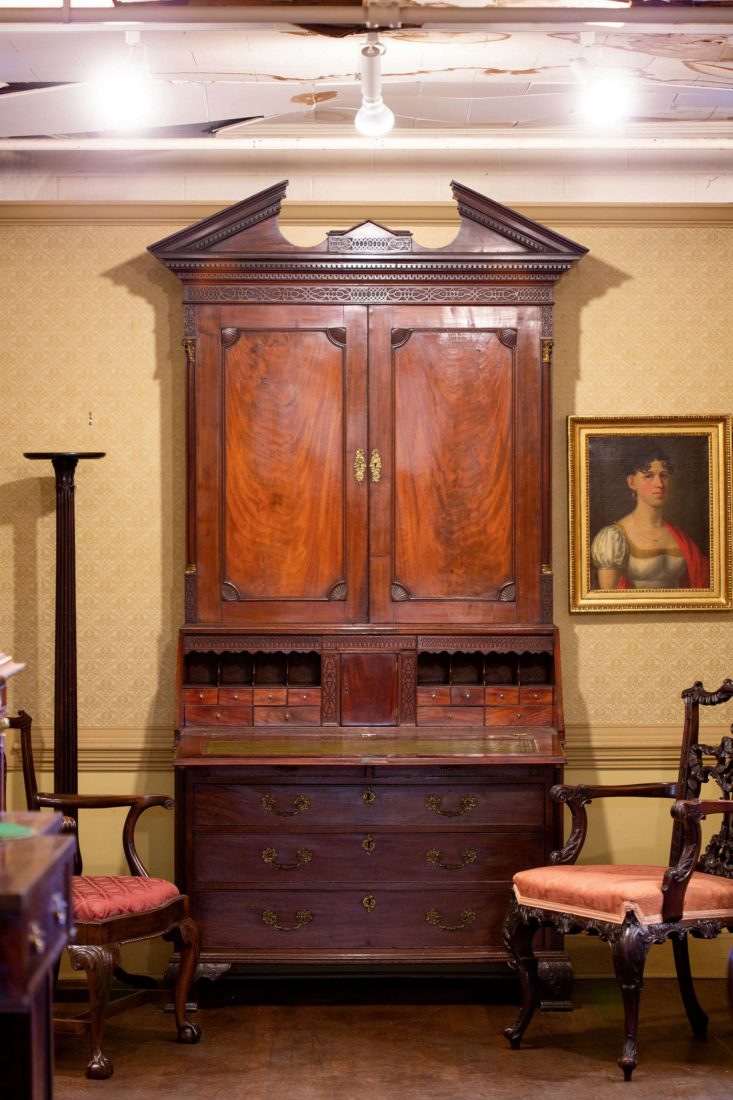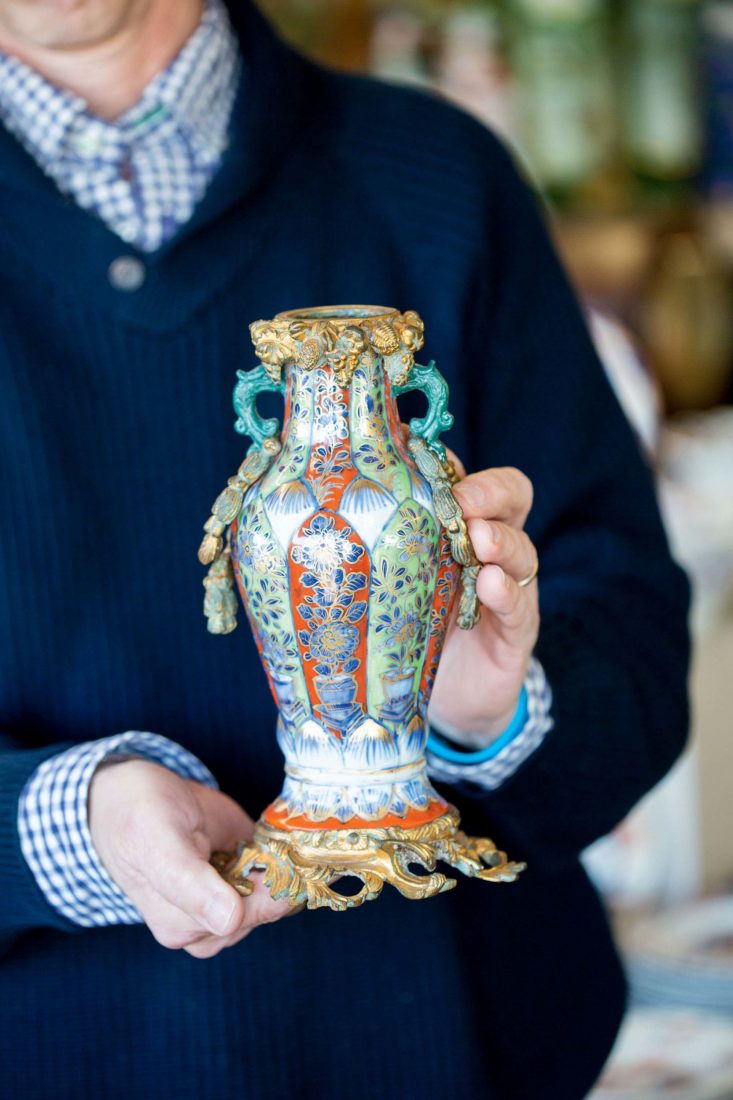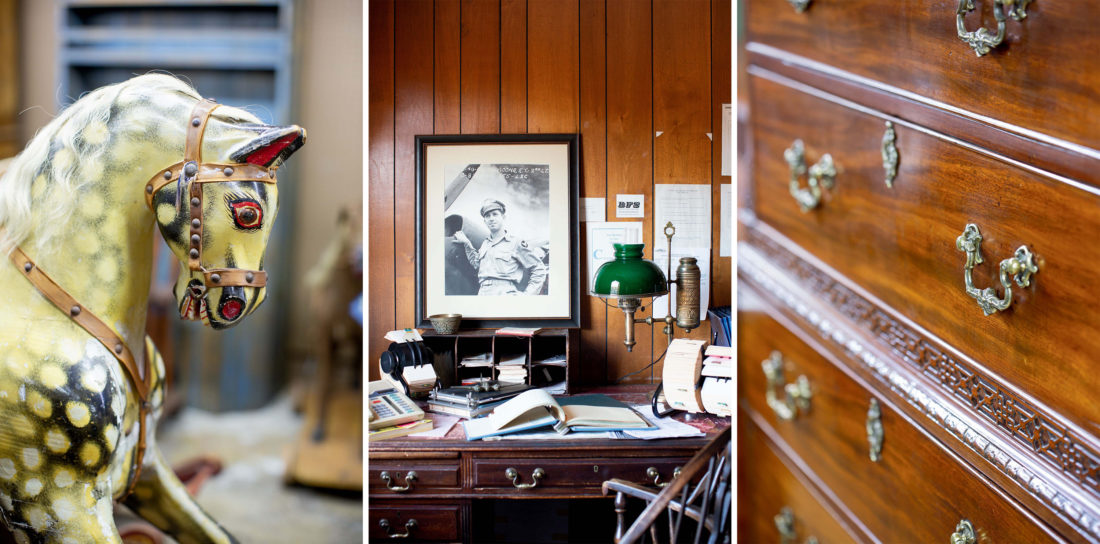There’s no telling how many road-trippers have exited I-95 near Wilson, North Carolina, and started in on a plate of chopped pork at Parker’s Barbecue without realizing their proximity to another Southern treasure: Boone’s Antiques. A mere half mile from the famous ’cue joint, fronting a lonely stretch of U.S. Route 301, the sixty-five-year-old business occupies a compound of nondescript showrooms and warehouses.
The buildings were just as humble during Boone’s heyday, but the hordes of buyers they drew are the stuff of legend. Yes, celebrities dropped by—Michelle Pfeiffer to buy an Oriental rug, Martha Stewart shopping for beds for her Maine house, North Carolina’s own Andy Griffith. One day, a shiny black tour bus rolled into the lot, and Johnny Cash stepped out, entourage in tow, and went looking for a silver service for his Tennessee home. But the real excitement happened during Edgar Boone’s infamous tag sales. The two-day events were a cross between a tweedy academic conference and a pro-wrestling cage match.

The tag sales started in 1961, when Boone, a former tobacco auctioneer, imported his first boatload of British antiques. These were pedigreed pieces as old as or older than the United States of America. The vast majority were English, made by master craftsmen during the reigns of Kings George I, II, and III. The cache included chest-on-chests, secretaries, Chippendale chairs, pewter, silver, and Chinese porcelain. Soon, Boone was holding multiple sales per year.
Dealers showed up Friday for the Saturday and Sunday sale. They registered their names on a legal pad and camped out to avoid losing their places in line. They brought sleeping bags and televisions and set up bars. When Boone learned that unscrupulous dealers were scaling the warehouse wall at night and shining flashlights down through a gap in the wallboard for a sneak peek, he strung up wire mesh.
On sale Saturdays, doors opened precisely at 8:00 a.m. Dealers rushed the door, jockeying for position and staking their claims. “It was like a feeding frenzy,” says Tom Boone, who is seventy-one and runs the business with his brother Doug, who is sixty-seven. “Daddy said, ‘Why price things high and sit on them?’”
Hugh B. Jackson, the son of Lynchburg, Virginia, antique dealers, got dragged along to many a Boone’s tag sale as a boy. He remembers playing in the Rolls-Royces Edgar shipped back from England along with his case goods. “It was crazy,” he says. “Dad would slip me and my brother into the sale and say, ‘Boys, look for tea caddies.’”
The longtime New York antique dealer John Rosselli calls it the best source of imported continental furniture on the East Coast, though he went for the oddities. “You might see three hundred pairs of antlers or great hampers full of the most beautiful linen—dinner napkins that were four feet square,” he recalls. “It was marvelous. It was like Christmas morning.”
Edgar Boone made his way to Wilson, one of the world’s busiest tobacco markets, in 1949. The antique buff soon convinced his boss, the auction-house owner, to let him sell furniture in the tobacco bullpen during the off-season. In 1955, he opened a storefront, and demand grew so feverish that Boone asked a local bank for a line of credit to boost his purchasing power. But the loan manager turned him down. “Daddy walked down to BB&T and asked Jack Satchwell for the same thing,” Doug recalls. He too was skeptical, so Edgar invited him to a tag sale and parked him beside the door early that Saturday morning. “This sale happened to feature a large lot of fine pewter,” Tom says. “Two dealers in particular—Nan Woodside and Sam Dethridge—loved pewter. When the doors opened, Sam stuck out his leg and tripped Nan so he could beat her to the pewter.” Satchwell saw the whole thing—the mad dash, the underhanded tactics. He told Edgar, “You can have all the money you want!”

By the 1990s, Boone’s had expanded with satellite locations in Kentucky, Virginia, North Carolina, and Georgia. But then Edgar Boone died in 1999 at the age of eighty-two, around the time design tastes underwent a sea change. Trends shifted to rooms with midcentury modern furniture. Many young people began to view antiques, even family heirlooms, as millstones tied to their necks.
The downturn tested Edgar’s sons. Over the past fifteen years, the Boone brothers have closed all the satellite shops and hunkered down in Wilson. Today rows of grandfather clocks stand heel to toe in one warehouse, while in another, paths snake in between long rows of Georgian chests of drawers. Fans worry that the Southern institution will close, like so many of its kind.
“It’s so sad to see antique and architectural salvage stores closing,” says the Washington, D.C., designer Darryl Carter. “Beautiful, classical, patinated antiques lend heart and soul to a room that may otherwise feel unwelcoming if singularly populated with only modern decor. The marriage of antique and modern is the very ethos of my design.”
The Boone brothers aren’t throwing in the towel just yet. Not long ago the website 1stdibs, which bills itself as the “world’s leading online marketplace for the most beautiful things on earth,” contracted with Boone’s to list its pieces, an indication that brown furniture is back. Boone’s also does a brisk business renting to film and television production companies.

“I’ve gone to Boone’s for every period show I’ve worked on,” says the set decorator Marthe Pineau, who left Hollywood for Wilmington, North Carolina, twenty-five years ago. She sourced from Boone’s for the 2019 movie Harriet, and an upcoming Showtime series based on James McBride’s novel The Good Lord Bird. “I’m in awe of the Boone brothers. The pieces speak to me. They have this living spirit. When I came from California, one thing I noticed about the South immediately was the connection to the past. If Boone’s goes away, I’ll be crying.”
“People will always have an interest in the past,” Tom says. “They’ll come around to traditional antiques. Besides,” he says, pointing to a Chippendale chest-on-chest with original brass hardware, “that piece is now cheaper than a brand-new one of the same size but inferior quality.” The fact that it’s 250 years old and handmade from fine hardwoods is just a bonus.








